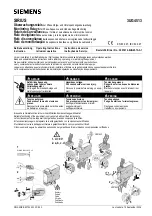
Tamper-Resistant Full-Load Current
Cover
Adjustment Dial
Protection Class
S itch
Remote Reset
0
Current Transformer
Trip Indicator &Manual
Trip Test Lever
(shown in ON position)
Terminals (bottom)
Figure 2. Top face of Solid State Overload Relay, with controls and
features indicated.
Adjusting the Solid State Overload
Relay
The following adjustments to the Solid State Overload
Relay are illustrated in Figure 2. The adjustments
should be performed in the following order.
The settings as the unit is received from the factory
are as follows:
• Full-load current at minimum.
• Protection class at 20.
Full-Load Current Adjustment
This setting is the current beyond which the Solid
State Overload Relay will trip. Use the following
guidelines to determine the appropriate setting:
• For motors with a service factor of 1.0, set the full
load current on the Solid State Overload Relay to
0.9 times the full-load amps (FLA) rating on the
motor's nameplate.
• For motors with a service factor of 1.15-1.25, set
the full-load current on the Solid State Overload
Relay to the FLA rating on the motor's
nameplate.
Press on the tamper-resistant cover above the FLA dial,
then lift up near the tab on the other side to remove
the cover. Rotate the FLA dial so that the arrow on the
dial points to the desired current, as indicated by the
ampere markings around the dial. Do not rotate past
the marked area. The knob moves in small steps to
allow precise adjustment of the full-load current.
Replace the tamper-resistant cover to provide addi-
tional dust protection. To protect against unauthorized
persons' tampering with the settings, insert a wire
lock through the locking tabs.
Phase Loss Sensitivity
The Solid State Overload Relay contains a trip function
activated by a phase loss. This protection is activated when
one phase loses current and either one of the remaining
phase currents exceeds 95% of the minimum FLA of the
Overload Relay. A phase loss trip occurs within 3-6 seconds
of loss of phase current.
Protection Class Setting
CAUTION:
The slide switch must be in one of the
three detent positions. If the slide is between one of
the detents, the default is protection class 30.
AITENTION:
Le bouton de selection de la classe de
protection doit etre dans une des trois positions stables.
Si le bouton se trouve entre deux positions, la classe de
protection est fixee a 30 par default.
Set the desired protection class to 10, 20, or 30 by
sliding the switch to the appropriate detent position.
The time-current curves for the protection classes are
shown in Figure 3. Select the class appropriate to the
particular application.
1000
iii
,:,
C
¥
100
�
E
j::
Cl)
C
·a
� 10
I,.
,'\.
��
�
-
.....
-
-
..__
"""""
........
---
-....i,,...
1--......
...............
1-..............
--
...
r---,......
-..............,
--
..........
r-
r--
r-,...
-
Class 30
Class 20
Class 10
2
3
4
5
6 7 8 9 10
Multiples of Full Load Amps setting
Figure 3. Time-current curves (cold state) for the protection classes.
Test
for Welded Contacts
The following
procedure can be
performed
periodically to insure that the Solid State Overload
Relay contacts have not welded because of a short
circuit in the control circuit.
1. Disconnect all power and control wiring from
the Solid State Overload Relay.
2. Place a bell set or resistance-measuring
instrument across the NC relay terminals (95
and 96).
Содержание CR324GXNS
Страница 3: ......






















